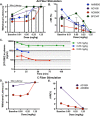Discovery of a selective, state-independent inhibitor of NaV1.7 by modification of guanidinium toxins
- PMID: 32908170
- PMCID: PMC7481244
- DOI: 10.1038/s41598-020-71135-2
Discovery of a selective, state-independent inhibitor of NaV1.7 by modification of guanidinium toxins
Abstract
The voltage-gated sodium channel isoform NaV1.7 is highly expressed in dorsal root ganglion neurons and is obligatory for nociceptive signal transmission. Genetic gain-of-function and loss-of-function NaV1.7 mutations have been identified in select individuals, and are associated with episodic extreme pain disorders and insensitivity to pain, respectively. These findings implicate NaV1.7 as a key pharmacotherapeutic target for the treatment of pain. While several small molecules targeting NaV1.7 have been advanced to clinical development, no NaV1.7-selective compound has shown convincing efficacy in clinical pain applications. Here we describe the discovery and characterization of ST-2262, a NaV1.7 inhibitor that blocks the extracellular vestibule of the channel with an IC50 of 72 nM and greater than 200-fold selectivity over off-target sodium channel isoforms, NaV1.1-1.6 and NaV1.8. In contrast to other NaV1.7 inhibitors that preferentially inhibit the inactivated state of the channel, ST-2262 is equipotent in a protocol that favors the resting state of the channel, a protocol that favors the inactivated state, and a high frequency protocol. In a non-human primate study, animals treated with ST-2262 exhibited reduced sensitivity to noxious heat. These findings establish the extracellular vestibule of the sodium channel as a viable receptor site for the design of selective ligands targeting NaV1.7.
Conflict of interest statement
H.P., J.T.B., A.D., G.L., D.M., X.Z. and J.V.M. are employees of and shareholders in SiteOne Therapeutics. D.C.Y. and J.D.B. are advisors to and shareholders in SiteOne Therapeutics.
Figures




References
-
- Dib-Hajj SD, Yang Y, Black JA, Waxman SG. The NaV1.7 sodium channel: From molecule to man. Nat. Rev. Neurosci. 2013;14:49–62. - PubMed
-
- Goldberg Y, et al. Loss-of-function mutations in the Nav1.7 gene underlie congenital indifference to pain in multiple human populations. Clin. Genet. 2007;71:311–319. - PubMed
-
- Faber CG, et al. Gain of function NaV1.7 mutations in idiopathic small fiber neuropathy. Ann. Neurol. 2012;71:26–39. - PubMed
Publication types
MeSH terms
Substances
Grants and funding
LinkOut - more resources
Full Text Sources
Other Literature Sources

